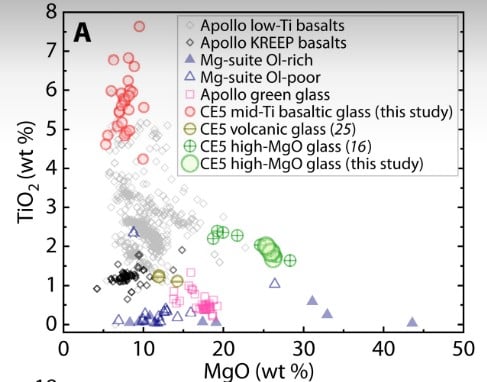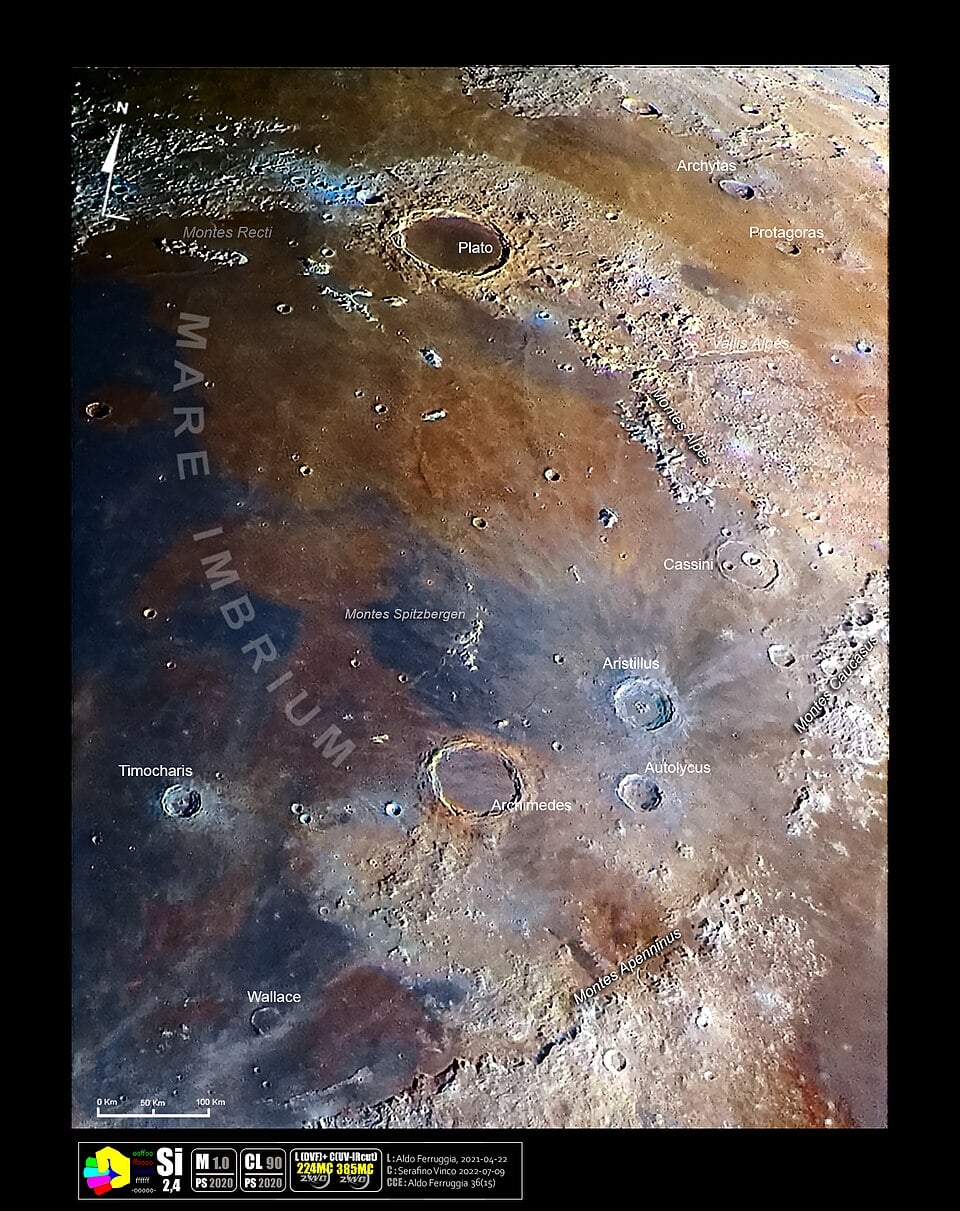If we could peel back the Moon's cratered crust and examine its mantle, we might find answers to some foundational questions about the Solar System. We lack the technological capability to excavate the Moon's mantle, but Nature has a way. A massive, ancient impact excavated material from deep beneath the Moon's crust and left it on the surface for us to find. It could help confirm the Moon's origins.
The Giant Impact Hypothesis(GIH) is the widely accepted explanation for the origin of the Moon. It proposes that a massive protoplanet about the size of Mars, named Theia, slammed into Earth about 4.5 billion years ago. The impact melted Theia and some of Earth, sending the material into orbit around Earth. Eventually, some of it coalesced into the Moon. The GIH was first proposed in 1946 but didn't attract much interest until decades later, when the Apollo lunar samples generated renewed interest.
 *This artist's illustration shows the protoplanet Theia impacting Earth more than 4 billion years ago. Image Credit: By NASA/JPL-Caltech, Public Domain*
*This artist's illustration shows the protoplanet Theia impacting Earth more than 4 billion years ago. Image Credit: By NASA/JPL-Caltech, Public Domain*
The GIH says that the Moon formed primarily from the mantles of Earth and Theia. The lunar samples supported this idea because their isotopic ratios are similar to Earth's. However, surface rock has been exposed to space weathering and impacts for billions of years, altering its composition. What we need is a sample of the untouched mantle.
Ancient, massive impacts like the one that created the Imbrium Basin had the power to excavate material from the mantle and spread it around the crust near the impact site. China's Chang'e-5 mission returned its samples to Earth in 2020, and they contained glass beads. These beads are common near energetic impact sites, where the intense heat blasts rock and melts it into little pieces that land back on the ground near the site.
Normally, impact beads are made of crustal material. In new research, scientists from Curtin University, Nanjing University, and the Australian National University examined a large lunar bead from the Chang'e mission and found that it contains an unusually high level of magnesium oxide (MgO). This indicates that its parent rock is from the Moon's upper mantle.
The research, titled "A potential mantle origin for precursor rocks of high-Mg impact glass beads in Chang'e-5 soil," appears in Science Advances. The lead author is Chen-Long Ding from the School of Earth Sciences and Engineering at Nanjing University in China.
Evidence shows that all lunar rock contains glass beads. These beads are from lava eruptions and impacts and provide a collective record of lunar history. Samples from different sites on the Moon confirm this. However, the Chang'e 5 samples are different.
"The chemical compositions of most lunar impact glass beads reflect mixing of crustal components, including mare basalts, highlands rocks, and KREEP[from high concentrations of K, REE (rare earth element), and P]," the authors write in their research article. "However, a few glass beads in the soil from the Chang'e-5 mission have unusually high MgO contents that require distinct target compositions."
The young age of the glass beads indicates that they come from the impact melting of ultramafic rock, which generally contains higher amounts of MgO. "Of particular interest here is a group of glasses with MgO contents exceeding 18 wt% %," the authors write. "The high MgO concentrations clearly differentiate them from the local basalt and regolith at the Chang'e-5 landing site, which have MgO contents ~6.5 wt% %."
 This figure from the research illustrates the high concentration of Magnesium Oxide in the Chang'e 5 glass beads in this study. Image Credit: Ding et al. 2025, Science Advances.
This figure from the research illustrates the high concentration of Magnesium Oxide in the Chang'e 5 glass beads in this study. Image Credit: Ding et al. 2025, Science Advances.
Though these rocks could be from surface material, they don't appear similar to any of the Moon's known lithologies. "Alternatively, these high-Mg beads might be sampling the upper mantle brought to the surface by the Imbrium basin–forming event," the researchers write.
Professor Alexander Nemchin from the School of Earth and Planetary Sciences at Curtin University in Perth, Australia, is one of the study's co-authors. In a press release, Nemchin said, "These high-magnesium glass beads may have formed when an asteroid smashed into rocks that originated from the mantle deep within the Moon. This is exciting because we've never sampled the mantle directly before: the tiny glass beads offer us a glimpse of the Moon's hidden interior."
Professor Tim Johnson, also from Curtin's School of Earth and Planetary Sciences, is one of the paper's co-authors. Since the rocks' chemistry is so different from that of other lunar samples, they could've been excavated by a massive impact.
One such event could be the formation of the Imbrium Basin, which is a huge crater formed more than 3 billion years ago," Professor Johnson said. "Remote sensing has shown the area around the basin's edge contains the kind of minerals that match the glass bead chemistry.
"This is a big step forward in understanding how the Moon evolved internally; if these samples really are pieces of the mantle, it tells us that impacts can excavate otherwise inaccessible mantle material to the surface," Johnson said.
While volcanism can produce similar types of glass beads, the authors explain why it's not likely that these beads are volcanic. The mission's sample includes other glass beads of various ages. For all of them to be volcanic, there must have been multiple volcanic eruptions in the region very early in the Moon's history. However, while impacts can spread their glass beads over a wide area, volcanoes don't have the same reach, and their glass beads tend to accumulate near the center of the eruption. There's no evidence of that accumulation. "Therefore, while the possibility of very young volcanism on the Moon is provocative, there is no geological evidence for this, and we interpret the high-MgO beads in the Chang'e-5 regolith to have an impact origin," they write.
These results can't confirm the Giant Impact Hypothesis. But they do support the idea that the Moon experienced a magma ocean phase during its formation, which the GIH predicts. This opens a window into the Moon's deeper interior that wasn't there before. Scientists will work with these results and see what they tell them about the Moon and the Solar System. The results may help them constrain lunar magma ocean crystallization models and determine whether the mantle is rich in olivine and pyroxene, as predicted.
Understanding how the Moon's interior is made helps us compare it to Earth and other planets," said co-author Professor Xiaolei Wang from Nanjing University. "It could even guide future missions, whether robotic or human, that aim to explore the Moon's deep geology.
Press Release:Glass beads offer a window into the Moon's hidden depths
Research:A potential mantle origin for precursor rocks of high-Mg impact glass beads in Chang'e-5 soil
 Universe Today
Universe Today
